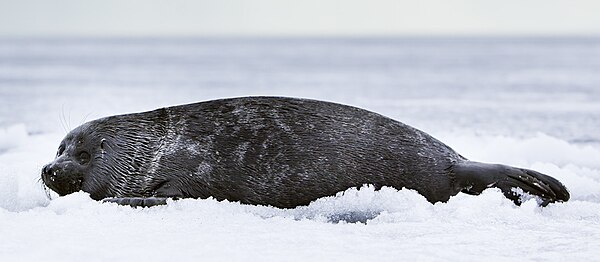Pusa sibirica
The nerpa (Pusa sibirica) is a species of pinniped mammal of the Phocid family. It is a seal endemic to Lake Baikal. Nerpa are one of only two species of seal that spend their entire lives in freshwater (the other species is the seal Pusa hispida saimensis.)
The total population is estimated at more than 60,000 animals. Hunting was widely practiced in the past, but restrictions on it have recently become stronger. Hunting nerpas over frozen Lake Baikal is a dangerous activity, and many hunters drown each year.
Main features
They are the longest-lived seals (up to 56 years in females) and also the smallest pinnipeds. The length of the specimens varies between 130 and 140 centimeters, with an average weight of 70 kg (there is a very slight sexual dimorphism that makes male specimens slightly larger than females).
The skin is a color whose tones vary from white to black, with the upper part being a dark gray tone and the lower part being a light gray tone.
Habits

The nerpa lives a large part of its time submerged in water thanks to its abundant blood and the high degree of oxygenation of the highest waters of the Baikal, thus it can remain immersed for up to 70 minutes. In the prolonged winter when the surface of the lake freezes, these animals are able to make holes in the ice, such holes serve as vents.
Food
The nerpa feeds mainly on fish and invertebrates, mainly on fish of the genus Comephorus (goloyanska), also endemic to Baikal, and on fish Cottocomephorus, such fish are also used for human consumption, which has meant serious competition for these resources.
Playback
Calving occurs in the water around the month of May, when the lake surface is still covered by ice. Pregnancy lasts nine months, commonly a single puppy is born, although twins are not uncommon. If twins are born, they accompany each other for a while before separating permanently.
As soon as born, a puppy weighs approximately 4.5 kg and has a length of approximately 65/70 cm, being then covered by soft long white hairs, such fur is maintained for the first six weeks and then replaced by the same type of coat as adult specimens. The cubs are nourished by their mothers during the first two months of life. It should be noted that in the southern area - where the ice melts sooner - the cubs are smaller than in the northern area of the lake. Females tend to become sexually mature between 3 to 6 years and males between 4 to 7. Approximately 88% of already sexually reproductive females have a cub each year until they are in their thirties.
Their presence in Lake Baikal
A scientific mystery is -still- how the Nerpas arrived at Lake Baikal, since it is located hundreds of kilometers from any ocean and in an elevated area almost completely surrounded by important mountains; The main speculations are two, the least probable is that it is a superstite species from the Tertiary period, however it seems much more likely that its presence in this remote continental lake dates back to the Wurmian between 30 thousand to 15 thousand years ago, at that time The glaciation would have covered most of Siberia with a layer of ice, such a mass of ice would have indicated the waters that come out of the Angara River and after more than a thousand kilometers today flow into the Arctic Ocean through the Yenisey River; As the waters were dammed by the ice from the north, a large lake would have formed in the southern part of the now marshy plain of Western Siberia. The water surface of this lake was perhaps above the level of the current Angara basin, and the lake Baikal was then almost an arm at the southeastern end of the great Siberian paleolake. That is, the ice caps during the last great glaciation would have first covered the entire Arctic Ocean, pushing some seal populations to the south. These were able to thrive in a large Siberian paleolake and then, when the glacial transgression ceased, some seal populations (the nerpas) remained remnants in Baikal.
Contenido relacionado
(39) Laetitia
Lucy
(116) Sirona
